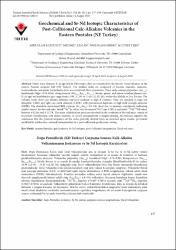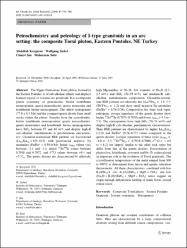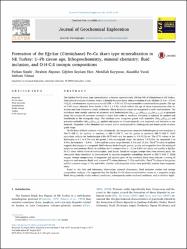Ara
Toplam kayıt 59, listelenen: 11-20
U-Pb zircon chronology and petrogenesis of Carboniferous plutons in the northern part of the Eastern Pontides, NE Turkey: Constraints for Paleozoic magmatism and geodynamic evolution
(Elsevier, 2016)
Numerous intrusive rocks of varying ages and compositions exist in the Paleozoic to Tertiary periods in the Eastern Pontides. Carboniferous intrusive rocks are commonly observed in the southern part of the Eastern Pontides. ...
Petrographical, geochemical and petrological characteristics of Eocene volcanic rocks in the Mescitli area, Eastern Pontides (NE Turkey)
(2016-12)
Mineralogical, petrographical and geochemical data are presented for the Eocene aged Mescitli volcanics in the Eastern Pontides (NE Turkey). The studied rocks are composed of basaltic andesitic, andesitic, ...
Geochemical and Sr-Nd isotopic characteristics of post-collisional calc-alkaline volcanics in the eastern Pontides (NE Turkey)
(2011)
Doğu Pontidlerde Eosen yaşlı Torul volkanitlerinin ana, iz element, K-Ar yaş ve Sr-Nd izotop verileri incelenmiştir. İncelenen volkanitler, bazaltik andezit, andezit, trakiandezit ve az oranda da trakidasit ve bunların ...
Petrochemistry and petrology of I-type granitoids in an arc setting: the composite Torul pluton, Eastern Pontides, NE Turkey
(Springer-Verlag 2007, 2007-04-16)
The Upper Cretaceous Torul pluton, located in the Eastern Pontides, is of sub-alkaline affinity and displays features typical of volcanic arc granitoids. It is a composite pluton consisting of granodiorite, biotite hornblende ...
Petrography, mineral chemistry and crystallization conditions of cenozoic plutonic rocks located to the north of Bayburt (Eastern Pontides, Turkey)
(Maden Tetkik Ve Arama Genel Mudurlugu-Mta, 2018)
The Eastern Pontides comprise many intrusive bodies varying in composition, size and age from Palaeozoic to Cenozoic. Especially Cenozoic aged bodies are commonly observed in the southern part, while they are rarely exposed ...
Geochemical and Sr-Nd-Pb isotope characteristics of the Miocene to Pliocene volcanic rocks from the Kandilli (Erzurum) area, Eastern Anatolia (Turkey): Implications for magma evolution in extension-related origin
(Elsevier Science Bv, 2018)
This paper presents Sr-Nd-Pb isotopic and whole-rock geochemical data of Miocene to Pliocene volcanic rocks in the Eastern Anatolia (Turkey) aiming to unravel their sources and evolutionary history. The wide compositional ...
Doğu Pontid Güney Zonu’ndaki (Bayburt) Tersiyer yaşlı intruzif kayaçların Petrokimyası, Jeokronolojisi ve İzotop Sistematikleri
(2019-02-28)
[Abstract Not Available]
Geochronological evidence and tectonic significance of Carboniferous magmatism in the southwest Trabzon area, eastern Pontides, Turkey
(Taylor & Francis Inc, 2012)
The northern and southern zones of the eastern Pontides (northeast Turkey) contain numerous plutons of varying ages and compositions. Geochemical and isotopic results on two Hercynian granitoid bodies located in the northern ...
Geochronology, geochemistry, and petrogenesis of the Eocene Bayburt intrusions, Eastern Pontide, NE Turkey: implications for lithospheric mantle and lower crustal sources in the high-K calc-alkaline magmatism
(2015-04-28)
Eocene I-type plutons are widespread in the Eastern Pontides, Northeastern Turkey. Geochemical and isotopic results on two Eocene intrusive bodies located in the southern zone of the Eastern Pontides were utilized to achieve ...
Formation of the Eğrikar (Gümüşhane) Fe–Cu skarn type mineralization in NE Turkey: U–Pb zircon age, lithogeochemistry, mineral chemistry, ?uid inclusion, and O-H-C-S isotopic compositions
(Journal of Geochemical Exploration, 2017)
[Abstract Not Available]


















